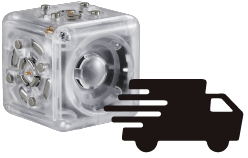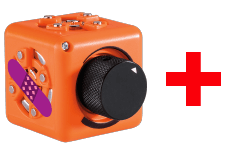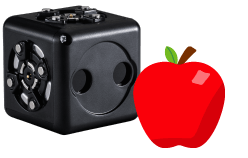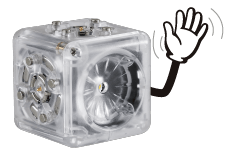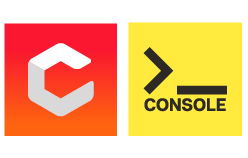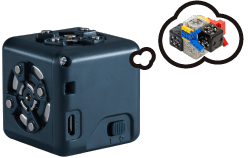PreK–K.
Meet Your Cubelets. > Scope and Sequence.
About.
This scope and sequence is designed for preschool-aged students (4+). Each lesson is intended to last 30 minutes and 28 weeks of lessons assumes students will have access to Cubelets at least once per week. Throughout the 28-week sequence are 6 “Open-Play Days”. These can be used as periodic assessment days to record how students’ play with Cubelets changes as a result of their learning opportunities. Please use your professional judgment in deciding when you need to repeat a lesson, skip a lesson, or combine two lessons based on your class and your students. View the Google Docs version here.
Jump to...
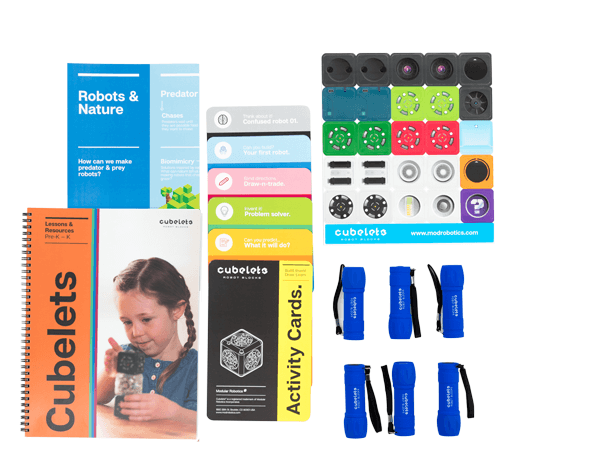
Want a printed lesson book?
Get this content and more great resources when you add a Cubelets Lesson Plan Bundle to your collection.
Cubelets Open Play.
Outline.
Students play with Cubelets naturally.
- As magnetic blocks.
- Turning the battery on and off.
- How to work in partners/small groups.
Objectives.
Students will use their natural curiosity to explore Cubelets.
Objectives.
Teachers look for:
- Student collaboration skills.
- Turning the Battery on and off.
- Students noticing black SENSE blocks.
Robot Bodies and Human Bodies.
Outline.
- Read Boy+Bot by Ame Dyckman.
- Students compare and contrast robots and humans.
- Introduce Battery Cubelet
- Introduce SENSE, THINK, and ACT with Red light, Green light game.
Objectives.
Students will notice the similarities between human bodies and robot bodies.
Objectives.
Teachers listen for:
- Students remembering the definition of a robot.
- Students making comparisons between human bodies and robot bodies.
- Students understand robots need power.
Driving Bots.
Outline.
Read The Robot Book by Heather Brown.
Students sort Cubelets by “job.” (no Think Cubes right now)
- Black Cubes are SENSE cubes.
- Clear Cubes are ACTION cubes.
- Battery is by itself.
- Introduce SENSE, THINK, and ACT with Red light, Green light game.
Class plays Red Light, Green Light.
Objectives.
Students will sort Cubelets based on similarities, and notice what makes each Cubelet unique.
Objectives.
Teachers look for:
- Student collaboration skills.
- Students sort by color.
- Students share observations of what makes each Cubelet block unique.
Driving Bots.
Outline.
Students assemble “Cuddle-Bot” and “Fraidy-Bot” using Drive Cubelets, Battery Cubelets, and Distance Cubelets. (remove all other Cubelets for this lesson)
Objectives.
Students will practice flexible thinking by redesigning their robots for different jobs.
Objectives.
Teachers look for:
- Students count to three.
- Students rotate individual Cubelets within a robot.
- Students switch the order of blocks in their robot.
- Students remember the goal they are designing toward.
Act Out Cubelets.
Outline.
Warm-up with a game of Red Light, Green Light.
Then, In groups of three, one team builds a robot, the other team acts out the robot.
Take turns switching off which team does which.
Objectives.
Students will act out the Cubelets within a 3-block robot.
Objectives.
Teachers look for:
- Students remember what each robot block does.
- Students use collaboration skills.
- Students give constructive feedback to peers.
Cubelets Open Play.
Outline.
Students play with Cubelets naturally. (no Think Cubes, but include all action/sense cubes)
- As magnetic blocks.
- Turning the battery on and off.
- How to work in partners/small groups.
Objectives.
Students will use their natural curiosity and prior experience to explore Cubelets.
Objectives.
Teachers look for:
- How students play differently with Cubelets than the first Open-Play day.
- Student collaboration skills.
- Students design for a purpose.
Modeling Robots.
Outline.
Read Aloud “What is a Scientist?” By Barbara Lehn
Students draw models of the robots they build. (Limit again to “Cuddle-Bot” and “Fraidy Bot”)
Objectives.
Students will practice scientific modeling by drawing models of the robots they build.
Objectives.
Teachers look for:
- Students drawing with unique properties in mind.
- Students use words to explain their drawings.
- Note: scaffold modeling with this worksheet.
Investigating ACT Cubelets.
Outline.
Read aloud “Robot Rumpus” by Sean Taylor.
Students investigate each ACT Cubelet. (each group has only one battery and one Distance Cubelet. They will trade out the ACT Cubelets one by one)
- Choose favorites.
- Practice naming.
- Practice counting to two versus counting to three.
- Remember SENSE, ACT, and BATTERY vocabulary words.
Objectives.
Students will use the scientific method to investigate ACT Cubelets.
Objectives.
Teachers look for:
- Student collaboration skills.
- Students use only one ACT Cubelet at a time.
- Students explain what each ACT Cubelet does.
- Students practice using the name of each ACT Cubelet.
Modeling Robots.
Outline.
Students draw models of the robots they build. (Available Cubelets include all ACT Cubelets, Distance Cubelet, and Battery Cubelet)
Objectives.
Students will practice scientific modeling by drawing models of the robots they build.
Objectives.
Teachers look for:
- Students drawing with unique properties in mind.
- Students use words to explain their drawings.
- Note: scaffold modeling with this worksheet.
Act Out Cubelets.
Outline.
Warm-up with a game of Red Light, Green Light.
Then, In groups of three, one team builds a robot, the other team acts out the robot.
Take turns switching off which team does which.
Objectives.
Students will act out the Cubelets within a 3-block robot.
Objectives.
Teachers look for:
- Students remember what each robot block does.
- Students use collaboration skills.
- Students give constructive feedback to peers.
Cubelets Open Play.
Outline.
Students play with Cubelets naturally. (no Think Cubes, but include all action/sense cubes)
- As magnetic blocks.
- Turning the battery on and off.
- How to work in partners/small groups.
Objectives.
Students will use their natural curiosity and prior experience to explore Cubelets.
Objectives.
Teachers look for:
- How students play differently with Cubelets. than the last Open-Play day
- Student collaboration skills.
- Students design for a purpose.
Investigating SENSE Cubelets.
Outline.
Read Aloud “My Five Senses” by Aliki.
Students investigate each SENSE Cubelet. (each group has only one battery and one ACT Cubelet of their choice. They will trade out the SENSE Cubelets one by one)
- Choose favorites.
- Practice naming.
- Practice counting to two versus counting to three.
- Remember SENSE, ACT, and BATTERY vocabulary words.
Objectives.
Students will use the scientific method to investigate SENSE Cubelets.
Objectives.
Teachers look for:
- Student collaboration skills.
- Students use only one SENSE Cubelet at a time.
- Students explain what each SENSE Cubelet does.
- Students practice using the name of each SENSE Cubelet.
Modeling Robots.
Outline.
Students draw models of the robots they build. (Available Cubelets include all ACT Cubelets, Distance Cubelet, and Battery Cubelet)
Objectives.
Students will practice scientific modeling by drawing models of the robots they build.
Objectives.
Teachers look for:
- Students drawing with unique properties in mind.
- Students use words to explain their drawings.
- Note: scaffold modeling with this worksheet.
- Note: extend modeling with this robot tracker worksheet.
Act Out Cubelets.
Outline.
Warm-up with a game of Red Light, Green Light.
Then, in groups of three, one team builds a robot, the other team acts out the robot. Take turns switching off which team does which.
Objectives.
Students will act out the Cubelets within a 3-block robot.
Objectives.
Teachers look for:
- Students remember what each robot block does.
- Students use collaboration skills.
- Students give constructive feedback to peers.
Cubelets Open Play.
Outline.
Students play with Cubelets naturally. (no Think Cubes, but include all action/sense cubes)
- As magnetic blocks.
- Turning the battery on and off.
- How to work in partners/small groups.
Objectives.
Students will use their natural curiosity and prior experience to explore Cubelets.
Objectives.
Teachers look for:
- How students play differently with Cubelets than the last Open-Play day.
- Student collaboration skills.
- Students design for a purpose.
Cubelets Storytelling Part 1.
Outline.
Read aloud “Rocket Writes a Story” by Tad Hills.
Students build a 3-Cubelet robot with their group.
- Draw a picture of their robot IN a story.
- Could be tied to seasons or holidays or special places or imaginations.
- Students share what they drew.
Objectives.
Students will practice telling stories based on their understanding of how their Cubelet robot SENSEs and ACTs.
Objectives.
Teachers look for:
- Students describe their robot accurately.
- Students tell a story with a beginning, middle, and end.
- Students collaborate with peers.
Cubelets Storytelling Part 2.
Outline.
Students build a 3-Cubelet robot with their group.
- Draw a picture of their robot IN a story.
- Could be tied to seasons or holidays or special places or imaginations.
- Students share what they drew.
Objectives.
Students will practice telling stories based on their understanding of how their Cubelet robot SENSEs and ACTs.
Objectives.
Teachers look for:
- Students describe their robot accurately.
- Students tell a story with a beginning, middle, and end.
- Students collaborate with peers.
Introducing Cubelets Challenges.
Outline.
Read aloud “The Most Magnificent Thing” by Ashley Spires.
Choose challenges from the robots in this video.
- Ask students to make a “Cuddle-Bot”.
- Ask students to make a “Dim Bot”.
- Ask students to make a “Dizzy Bot”.
Objectives.
Students will use critical thinking skills to build a specific robot based on a description.
Objectives.
Teachers look for:
- Students understand the description of a robot.
- Students stay on task.
- Students collaborate with peers.
Cubelets Open Play.
Outline.
Students play with Cubelets naturally. (no Think Cubes, but include all action/sense cubes)
- As magnetic blocks.
- Turning the battery on and off.
- How to work in partners/small groups.
Objectives.
Students will use their natural curiosity and prior experience to explore Cubelets.
Objectives.
Teachers look for:
- How students play differently with Cubelets than the first Open-Play day.
- Student collaboration skills.
- Students design for a purpose.
Investigating Two SENSE Cubelets.
Outline.
Students investigate building 4-Cubelet robots using 2 ACT cubes, 1 Battery, and 1 SENSE of their choice.
- How many combinations can they come up with?
- Counting to 2 vs. 3 vs. 4.
- Students practice naming their robots.
Objectives.
Students apply their understanding of SENSE Cubelets to robots that use 2 SENSE Cubelets.
Objectives.
Teachers look for:
- Student collaboration skills.
- How many different robots students build with the. same two ACT Cubelets
- Students switch the order of Cubelet blocks in their robot.
- Students rotate individual Cubelet blocks within their robot to improve it.
- Students say “I wonder” and “What if?”
Act Out Cubelets with Four Blocks.
Outline.
Warm-up with a game of Red Light, Green Light.
Then, in groups of four, one team builds a robot, the other team acts out the robot. Take turns switching off which team does which.
Objectives.
Students will act out the Cubelets within a 4-block robot.
Objectives.
Teachers look for:
- Students remember what each robot block does.
- Students use collaboration skills.
- Students give constructive feedback to peers.
Cubelets Storytelling Part 1.
Outline.
Read Aloud “The Really Silly Robot” by Gordon True.
Students build a 3- or 4-Cubelet robot with their group.
- Draw a picture of their robot IN a story.
- Could be tied to seasons or holidays or special places or imaginations.
- Students share what they drew.
Objectives.
Students will act out the Cubelets within a 4-block robot.
Objectives.
Teachers look for:
- Students remember what each robot block does.
- Students use collaboration skills.
- Students give constructive feedback to peers.
Cubelets Storytelling Part 2.
Outline.
Students build a 3- or 4-Cubelet robot with their group.
- Draw a picture of their robot IN a story.
- Could be tied to seasons or holidays or special places or imaginations.
- Students share what they drew.
Objectives.
Students will practice telling stories based on their understanding of how their Cubelet robot SENSEs and ACTs.
Objectives.
Teachers look for:
- Students describe their robot accurately.
- Students tell a story with a beginning, middle, and end.
- Students collaborate with peers.
Cubelets Challenge.
Outline.
Ask students to make 3- and 4-Cubelet robots by describing their jobs. (ie. A robot that has a spinning light)
Objectives.
Students will use critical thinking skills to build a specific robot based on a description.
Objectives.
Teachers look for:
- Students understand the description of a robot.
- Students stay on task.
- Students collaborate with peers.
Modeling Robots.
Outline.
Students draw models of the robots they build. (Available Cubelets include all ACT Cubelets, Distance Cubelet, and Battery Cubelet)
Objectives.
Students will practice scientific modeling by drawing models of the robots they build.
Objectives.
Teachers look for:
- Students drawing with unique properties in mind.
- Students use words to explain their drawings.
- Note: scaffold modeling with this worksheet.
Cubelets Open Play.
Outline.
Students play with Cubelets naturally. (no Think Cubes, but include all action/sense cubes)
- As magnetic blocks.
- Turning the battery on and off.
- How to work in partners/small groups.
Objectives.
Students will use their natural curiosity and prior experience to explore Cubelets.
Objectives.
Teachers look for:
- How students play differently with Cubelets than the first Open-Play day.
- Student collaboration skills.
- Students design for a purpose.
THINK Cubelets.
Outline.
Read Aloud “The Hueys in What’s the Opposite?” by Oliver Jeffers.
Students investigate what happens when they add the red INVERSE Cubelet to their robots
Students investigate what happens when they add the green PASSIVE Cubelet to their robots
Objectives.
Students will apply the scientific method to investigate THINK Cubelets.
Objectives.
Teachers look for:
- Students test only one THINK Cubelet at a time.
- Students test THINK Cubelets multiple times with different ACT and SENSE Cubelets.
- Student collaboration skills.
- Students begin to apply THINK Cubelets using “what if” statements.
Act Out THINK Cubelets.
Outline.
Warm-up with a game of Red Light, Green Light. Halfway through, switch the meaning so Red Light means Go and Green Light means Stop. (like an INVERSE Cubelet)
In groups of four, students act out what the red INVERSE Cubelet does. (Including if the INVERSE is added and removed)
Students act out what the green PASSIVE Cubelet does. (Including if the PASSIVE is added and removed)
Objectives.
Students will demonstrate their understanding of THINK Cubelets through acting.
Objectives.
Teachers look for:
- Students remember what each robot block does.
- Students use collaboration skills.
- Students give constructive feedback to peers.








